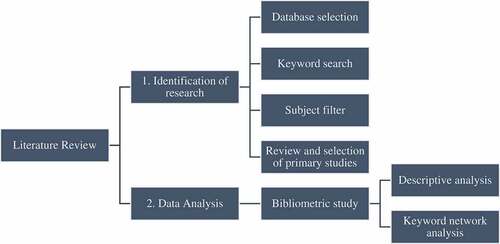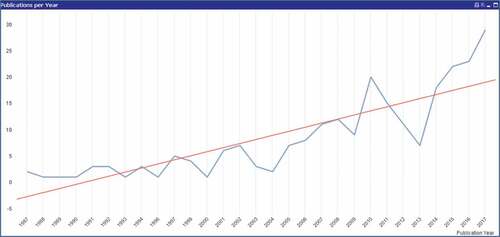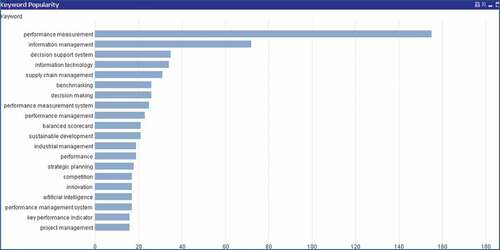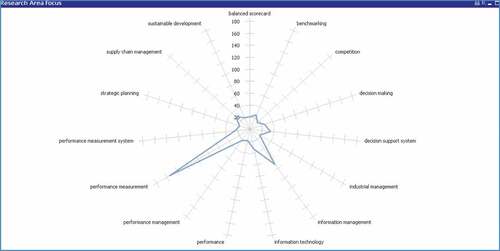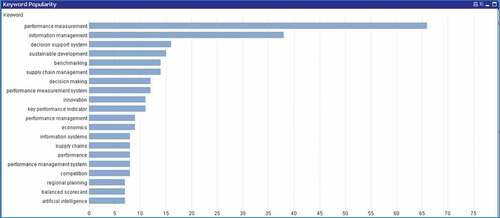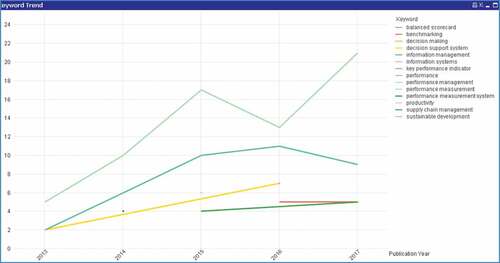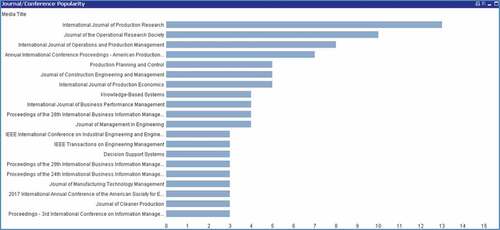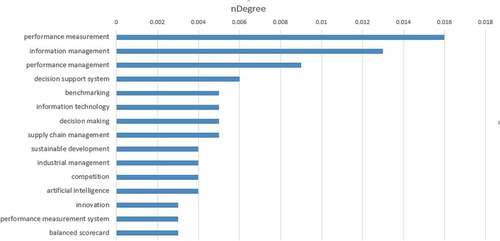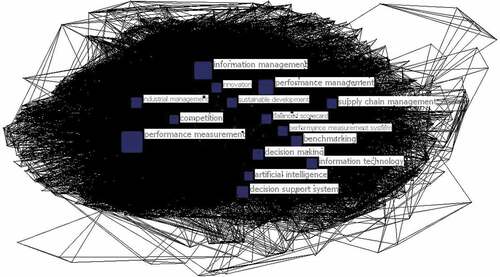Abstract
Purpose
Given the rise of big data and use of analytics, this study explores how the performance measurement systems research field has incorporated dynamic aspects and digitalization prevalent in rapidly changing and competitive environments. Design/methodology/approach: In the study we conduct a software supported and iterative systematic literature review of the performance management field together with a keyword network analysis. The meta-analysis provided a quantitative method that identified gaps and directions. Findings: The findings suggest there is a link between performance measurement systems and dynamics, but the link is weak, and the main research does not incorporate dynamic elements. There is an observable research community interest in managing information for informed decisions through digitalization. However, two broad research perspectives on performance management systems in highly dynamic and competitive environments were identified, one group exploring dynamic conditions, and the other digital technologies and optimization. Researchers positioning themselves in the dynamic subgroup are likely take an organizational or human capital perspective when exploring applications of performance management systems, while the other group mainly pursues research within artificial intelligence, automatization, and optimization. There is limited research with coverage of both groups, highlighting a notable gap in the existing research. Practical implications: The study presents several identified gaps within performance management systems and dynamic environments to be addressed with further empirical research. In addition, k-core analysis presented a conceptual context to position future research. Continued research will help managers develop performance measurement systems, based on real-time data, that move synchronously with the rapidly changing environment rather than maintaining inert systems that might adversely affect performance. Originality/value: This paper contributes to the understanding of performance measurement and management research in dynamic and digital environments.
PUBLIC INTEREST STATEMENT
Business environments are in a constant state of change, with digitalization initiatives on senior managers’ agenda to drive business performance and stay ahead of the competition. Big data, automation, and various forms of IT support for decision-making are commonly explored. But while there is research on performance systems and management as well as on IT support tools such as information technology and decision support systems, these have mainly been developed in unchanging environment. This study shows how the current research focuses on a rather static context, where digital tools such as artificial intelligence and big data are used in an optimizing manner, while the changing environment requires an open-ended approach. It also shows that current endeavors are not sufficiently dynamic. Finally, the study identifies a focus on advanced performance management systems developed around streamlined processes that target substantial levels of data for daily tactical decisions.
1. Introduction
Traditional tools and models to support strategy-making are based on systematic collection of pre-defined and purposely collected data to address specific information needs of decision makers. Existing strategy theory describes how well-defined measures and indicators provide input to both accounting models and various strategic decisions (Constantiou & Kallinikos, Citation2015). Managers in these settings analyze their operations and develop efficient processes in linear steps, starting with the formulation of strategy and ending with implementation (Eisenhardt & Martin, Citation2000). Performance Measurement Systems (PMS) are used in this context to provide a more structured way of managing operations as they gauge performance and provide information supporting informed decisions (Neely, Citation1997). Here managers, through a cognitive and analytical process, translate their vision into performance measures to align management activities such as; decision-making, target setting, and performance evaluation with the achievements of strategic objectives (Franco-Santos, Lucianetti, & Bourne, Citation2012). However, digitalization and the use of big data challenges existing models for strategy-making, as its large-unstructured and miscellaneous nature does not fit well with existing models and tools, which in turn will need significant alternation or replacement (Constantiou & Kallinikos, Citation2015). Importantly, in contrast to traditional analysis where an analyst set aside data for analysis and modeling for decision makers, big data instead provides a constant fast-flowing stream of data which demands a more continuous approach to sampling, analyzing, and action (Davenport, Citation2014).
Many companies at the digital frontier has built capabilities around big data analysis to adapt and develop their business on almost a daily basis (George & Lin, Citation2017). As such, competition and the increased use of digitalization accelerates the speed of developments in services, products, as well as in processes. Notably, the pace of change challenges the traditional linearity in business development and necessitates faster responses to competitor moves. This rapid change is problematic for the typically static and linear nature of PMS in both its strategic or operational role (Bititci et al., Citation2000; Neely, Citation2005). In such changing environment, to ensure PMS remain relevant, a review of systems employed is normally advocated (Bititci et al., Citation2000; Bititci, Carrie, & Mcdevitt, Citation1997; Bourne & Neely, Citation2003; Kaplan & Norton, Citation2007; Kennerley & Neely, Citation2003; Micheli & Manzoni, Citation2010; Najmi, Rigas, & Fan, Citation2005). But such review process may be insufficiently dynamic (Bititci et al., Citation2000; Kolehmainen, Citation2010). Melnyk, Bititci, Platts, Tobias, and Andersen (Citation2014) note that if the environment is highly turbulent, management must revise the strategy more often, and in turn, change the associated performance measures as well. Thus, there is a need to identify how existing PMS theories and concepts are designed and employed in highly dynamic environments and thereby incorporate the conditions of a digitalized environment (Melnyk et al., Citation2014). This leads to the study’s first research question, which helps us establish the current workings of PMS in dynamic conditions:
RQ1: How has PMS research covered dynamic conditions?
Moreover, the main purpose of PMS is to support managers in the decision-making process by means of providing decision-useful information (Choong, Citation2013; Taticchi, Balachandran, & Tonelli, Citation2012; Taticchi, Tonelli, & Cagnazzo, Citation2010). In a dynamic and rapidly changing environment, the decision-making support function requires review. In digital and automated environments decision-making is often automated and highly data-driven (Schildt, Citation2017). This significantly shortens the time in the decision feedback-loop to increase competitiveness in rapidly changing environments but does require some degree of stability and streamlined processes to enable automatization. A form of data-driven management is on the rise where management of work is automated, broadly labeled Algorithmic Management (AM) (Schildt, Citation2017), which works in conjunction with big data management and Artificial Intelligence (AI). The AM software algorithms assume managerial functions and surrounding institutional devices that supports algorithms (Lee et al., Citation2015). Efficiencies are gained as optimizing algorithms can analyze large data sets to control processes to maximize pre-defined outputs, such as costs or revenues (Schildt, Citation2017) and decisions and corrections are made in real time. For example, there are AM applications in the ridesharing service industry where jobs are assigned, optimized, and evaluated through algorithms and tracked data in real time (Lee et al., Citation2015). AM is best applied in stable environments where pre-definitions are possible, while the AI operates well in a domain of uncertainty. AI is based on probabilistic theory to express uncertainty. The environment is constantly changing, and the algorithms are projected to guess (or make assumptions) of reality. AI allows computers, and in turn, managers, to learn from accessible data at a rate much faster than managers and generating insights typically otherwise remaining undetected (Angelis & Ribeiro Da Silva, Citation2019). Both these characteristics are important for decision-making in a fast-changing environment. In this way, digitalization and big data enable a range of opportunities for capturing data for real-time performance measurement and management. Hence, given the important issues around rapid change and digitalization and PMS, we ask a second and more specific research question:
RQ2: How does PMS research cover digitalization, algorithmic management and artificial intelligence?
Answering the two research questions helps us identify how PMS theories and concepts incorporate the dynamic element as well as manage it through the use of modern technologies. This provides both insights to existing knowledge gaps and indications as to how these are being resolved through adaptation and evolution. This in turn will provide the necessary foundation for any later required development of the theories and concepts to fit the prevalent digital environment. To answer the questions a systematic literature review was conducted followed by a keyword network analysis. An initial overview of the PMS literature in dynamic and fast-changing conditions is presented first to set the literature, before it is explored in more depth in the following analysis.
2. Performance measurement systems overview
The general literature on performance measurement and management systems is quite extensive, and several studies explore the nature of changing conditions. The focus here is on the latter. For example Neely (Citation1999) discuss the PMS revolution and suggest the changing nature of work, increasing competition, improvement initiatives, quality awards, changing organizational roles, and changing external demands together with surges in information technology has led to the increased popularity of PMS. Kennerley and Neely (Citation2002) identify that few organization have a systematic process in place to manage the evolution of their measurement systems and identified the forces that shape the evolution of PMS. Bourne et al. (Citation2003) contribute to the understanding of factors which influence the success or failure of performance measurement initiatives. Neely (Citation2005) present how the field of performance measurement has evolved. Among other findings, the need for dynamic rather than static PMS was called for together with a move from performance measurement to performance management. Srimai, Radford, and Wright (Citation2011) came to the same conclusions and identified, among other directions, that the path of evolution has moved from static to dynamic PMS with a focus on management instead of measurement. Taticchi and Balachandran (Citation2008), based on review of existing frameworks the authors developed a framework that integrates five systems: performance system, cost system, capability evaluation system, benchmarking system, and planning system. Derived from organizations increased desire to build innovative capabilities, Micheli and Mura (Citation2017) suggested a more comprehensive design of PMS could facilitate transitioning from a cost paradigm towards one supporting radical innovation rather than cost efficiencies. De Lima, Da Costa, and Angelis (Citation2008) present the development of a theoretical framework, organized as a set of design recommendations to guide the performance measurement system capabilities development in a strategic management system context. Among others, elements of continuous improvement capability, organizational learning, strategic management, and change management are highlighted with the recommendation measurement systems should be designed, implemented, and managed as dynamic systems. However, the common ground is that dynamic environments affect PMS.
Digitalization concerns turning internal and external interactions, business processes, and even business models into digital ones where information is digitally represented. This move is only possible, or economically interesting, due to technological advances in information technology including software, computing power, and surrounding devices such as mobile phones and sensors. With these developments, new opportunities within performance management emerge. Digitalization enable automatization of processes with Decision Support Systems that utilize data, information and analytics capabilities (Delen & Demirkan, Citation2013). Algorithms are developed that assume the role of making decisions and taking action based on a set of performance measures to adjust to changing conditions, such as AM (Schildt, Citation2017). The umbrella term for smart algorithms, or systems that understand, adapt and learn from its surrounding and take action to maximize outcomes is commonly AI, which holds many underlying developments, such as machine learning and natural language processing. AI technology can significantly assist decision-making as well as for activities within search and discovery as large amounts of data can be processed (Davenport, Citation2014). As such, AI often work in conjunction with Big Data defined as large unstructured and fast moving data (McAfee & Brynjolfsson, Citation2012), where applications normally aim to make operational choices that are either timelier or more efficient (Davenport, Citation2014; Schildt, Citation2017).
On digitalization, IT and AI the PMS literature is more scarce. Neely (Citation1999) highlight the power of information technology and how it has changed the way company performance is measured. Bourne et al. (Citation2003) identify the shared call for highly developed information systems for successful PMS initiatives. Bititci et al. (Citation2000) argue that PMS need to be dynamic to deploy changes in the internal and external environment. This is suggested to be accomplished with the use of IT-based systems, artificial intelligence, and neural networks to facilitate closed-loop systems. Peters, Wieder, Sutton, and Wakefield (Citation2016) investigated how quality in business intelligence systems improves the diagnostic and interactive dimensions of PMS, which are positively associated with competitive advantage. While there are articles discussing various opportunities for PMS based on digital information technology advances there is no common ground and no literature reviews describing fundamental elements of PMS in a highly digitalized environment.
3. Method
For this study, a systematic literature review was undertaken together with bibliometric and keyword network analysis. The systematic literature search method makes use of an iterative procedure where relevant articles are searched, checked and reviewed for relevance until the whole literature review is complete (Tranfield, Denyer, & Smart, Citation2003). Subsequent meta-analysis provides a quantitative method to increase the quality and comprehensiveness in literature reviews and undertaken in this study based on synthesis of keywords to identify trends, gaps, and directions of the PMS literature. The research design is visualized in Figure .
3.1. Identification of research—sample selection and literature search
The study is based on bibliometric data extracted from 241 papers published in 139 different journals and conference proceedings. To collect a wide range of peer-reviewed research literature from leading journals together with web sources, the sample was drawn from Scopus database that is one of the largest repositories of abstracts and citations of peer-reviewed literature. The review is concept-centric, as recommended by Webster and Watson (Citation2002). In all, the sample represents PMS in dynamic or highly competitive environments where companies automate with the help of digitalization to compete in highly competitive environments. By manually reviewing seminal contributions in the subject areas, such as Constantiou and Kallinikos (Citation2015), Teece, Pisano, and Shuen (Citation1997), Eisenhardt and Martin (Citation2000) and Schildt (Citation2017), the following concept derived search string and keywords were used for the literature search:
(“performance measurement” OR “performance measurement system*” OR “performance management system*”) AND ((dynami* OR “dynamic capabilit*” OR “dynamic manage*” OR “dynamic environment*” OR “dynamic market*” OR “organizational change*”) OR (“algorithmic manage*” OR automat* OR digital* OR algorithm* OR AI OR “artificial intellige*” OR “information technology” OR IT OR “industry 4.0” OR “big data” OR “decision support system*” OR “information management”))
The search generated 2560 articles searching author and indexed keywords. Inclusion criteria was that the literature is within business management to capture the management literature, and full paper published in peer-reviewed scientific journals or from conference proceedings. This was to ensure new topics and discussions are captured while maintaining quality of the included material, thus excluding media such as books, newspaper articles, and technical reports. 251 results remained after limiting the criteria to English, articles and conference papers, and the subject area to Business Management. Searching indexed keywords over merely author keywords was necessary to capture papers discussing elements of rapid change without necessary including it as keyword. A good example paper of what have would have ended up outside the periphery with simply an author keyword search is McAdam, Bititci, and Galbraith (Citation2017), who incorporate a DC and PMS perspective researching technology alignment and business strategy in rapidly changing markets, without including DC as a keyword. After deleting duplicates, 247 articles were left for manual review. Further inclusion criterion was that the papers discussed PMS in any form (e.g. performance measures or performance management) together with elements of either dynamics (e.g. rapid change, dynamic capabilities, organizational change) or digitalization (e.g. AM, automatization, IT). After reviewing the literature, six papers were excluded from the final sample based on these criteria totaling 241 papers.
3.2. Data analysis
To analyze the literature from the systematic literature review, a bibliometric approach was chosen. Bibliometric methods have previously been used in PMS research (e.g. Taticchi, Tonelli, & Pasqualino, Citation2013) or operations management in general (e.g. Pilkington & Liston-Heyes, Citation1999) to present developments, trends, and gaps in the subject fields. A descriptive analysis is first performed and presented based on the bibliometric data for a first understanding of the research area. Applied to the bibliometric data, the study adopts a keyword network analysis approach to identify conceptual networks. Keyword network analysis differs from, for example social network analysis, as it focuses on the structure of a system based on shared meaning, rather than connections between actors and partners. Thus, if nodes are connected their concepts overlap (Doerfel & Barnett, Citation1999). The method constructs a network of relationships among occurring words appearing in texts, comprehends content, and finds meaning (Kim & Jang, Citation2017) and allow to model relationships in graphs labeled with nodes and edges (Drieger, Citation2013). Thus, a group of publications in a thematic domain are represented by a conceptual network where keywords act as nodes and relationships, or links, are the edges enabling analysis of thematic trends and flows within a semantic domain (Dotsika & Watkins, Citation2017). Last, positional analysis was carried out by means of centrality measures, which indicate significant positions and connections (Dotsika & Watkins, Citation2017). Standard measures are chosen, being; degree centrality, closeness, eccentricity (farness), and betweenness. Degree centrality is chosen to identify the center of discourse, i.e. identify how central each keyword is in the network structure, as it measures the number of connection points that a keyword makes with other words. On the opposite, low degree centrality would identify keywords in the periphery and not central to the mainstream discourse (Freeman, Citation1979). Closeness centrality is chosen to identify a nodes distance to all other nodes, thus captures how near a keyword is to other keywords (Dotsika & Watkins, Citation2017), the lower distance the faster influence from this keyword can travel in the network community (Freeman, Citation1979). For larger networks, we include Eigenvector as a complement to closeness to identify the central actors, as recommended by Hanneman and Riddle (Citation2005). Betweenness indicates the frequency of how often a keyword fall between pairs of other points, and is useful to identify the potential of a point for control of communication (Freeman, Citation1979). In other words, if betweenness centrality of a keyword is high, it may have a great influence on the flow of information in the network. In addition, eccentricity, or farness, measures the distance from a node to the farthest node (Dotsika & Watkins, Citation2017), and was chosen to identify knowledge gaps and research opportunities. Network density is measured to understand how compact the community is, and a recommended measure of group cohesion (Wasserman & Faust, Citation1994). Finally, k-core analysis helps identify tightly interlinked and cohesive subgroups within the network (Wasserman & Faust, Citation1994). For our analysis we set out two objectives: identify and illustrate where the literature is pointing, and potentially where it is not pointing, and to identify and illustrate existing, and non-existing, relationships between knowledge groups.
Bibliometric information of; author(s), paper type (journal article or conference proceeding), paper title, publication media title, indexed keyword(s), number of citations, and publication year was organized using Mendeley® software. Most manual work organizing the information was related to including indexed and author keywords over only author keywords. Indexed keywords were included to generate a richer data set. It was noted that many keywords needed manual review. For example, keyword such as “balanced score card” was edited to “balanced scorecard” or plural forms such as “performance measurement systems” where edited to “performance measurement system”. The information was reviewed several times to ensure that data are correct, especially potential duplicates in keywords as indexed keywords were manually merged with author keywords, opening for potential risk of skewed results. From Mendeley® the information was extracted to Microsoft Excel® to enable subsequent synthesizing using Qlikview® software together with graphical presentations.
To generate information for the keyword network analysis, the web-application MC3R® by FLUXO Business and Industrial Automation was used to populate a square 1616 word*word keyword matrix together with statistical reports. Similar as for the bibliometric analysis above, information of; author(s), paper title, publication media title, indexed keyword(s), and publication year was reviewed for correctness. Keywords were edited in the same way as described previously to not risk two or more essentially same keywords are considered different during meta-analysis and accumulation of information. Subsequently UCINET/Netdraw (Borgatti, Everett, & Freeman, Citation2002) was used to diagram the results for the keyword network analysis, including the K-core analysis, and to capture the values of the chosen measures (degree centrality, closeness, betweenness centrality, eccentricity, eigenvector, and network density). The matrix was cleared for both isolates and pendants.
4. Findings
The findings are presented next, starting with descriptive analysis and followed by the keyword network analysis.
4.1. Descriptive analysis
As a first step, we present in Table a short review of the Scopus search results which illustrate the magnitude and popularity of the research areas.
Table 1. Search results from selected keywords on Scopus
Out of the articles with AM as keyword, all except one of the articles (published in 2012) are published between 2015–2018. The scarcity in articles and majority published in the last three years suggests AM as a research area is relatively new. The dynamic capability perspective, however, is fairly explored and spans between 1972–2018. However, the amount of publications increases per year, indicating an increased popularity.
Turning to the sample to investigate PMS in environments of rapid change, we see in Figure an increasing number of articles being published from 1987 to 2017. The most common keywords used are displayed below in Figure . The same keywords are presented in a web-diagram in Figure to illustrate the main keywords relative to each other.
As shown in Figure , between 2013–2018 there was a notable increase in articles, representing 40% of the total sample, which together with the trendline overall, supports the increased and growing popularity of PMS. Investigating the most common keywords between 2013–2018 in Figure we see “information management”, “decision support systems”, “sustainable development”, “supply chain management”, “decision making”, and “innovation” at the top. These are the main topics discussed in the sample population during this period.
Figure shows an increasing trend for the top keywords during this period being “information management”, “decision support systems”, “benchmarking”, and “supply chain management”. Sustainable development was popular in 2016, however, no trendline was identified.
The common and trending keywords; “information management”, “decision support systems”, “sustainable development”, and “supply chain management” represent the direction for contemporary and future mainstream research—a research area focused on decision-making, information management, sustainability, and supply chain. This is explored further in the network analysis.
Our full sample presents a collection of management, engineering, and operations journals which are presented in Figure . The top 20 journals and conference proceedings represents 39% (96) of all sampled articles and are considered representative for their relevance in the field and degree of popularity among authors. 54 (56%) of these 96 published articles are published in various Operations and Production journals. The main keywords were “supply chain management”, decision support systems”, “data envelopment analysis”, “decision making”, “information management”, and “artificial intelligence” suggesting a main interest in operations management by information and analytics combined with decision-making and supply chain.
In addition, 12 of the 96 articles (13%) are conference proceedings from conferences around Information Management, with a focus on business. The most popular conference is the International Business Information Management Association Conference on conference topics such as Innovation Management, Sustainability, Strategic Planning, and Smart Implementation. The main keywords from these conferences are “information management”, “economics”, “innovation”, and “sustainable development” suggesting a more comprehensive approach where information together with problems on a macro level are discussed.
From the full sample, we selected the top ten keywords (Figure ) and cleared for the main keywords such as “performance measurement systems” or “performance management”. It shows that “information management” and “decision support systems” in a PMS context have surged significantly in the last years, after being relatively stagnant. “Decision making” is also on the rise, as is “benchmarking”. Combined they suggest an environment with an abundance of information available for informed decisions requiring a system to synthesize and analyze information. Increased use of the keyword “benchmarking” suggests an increased interest in what competitors are doing in the competitive environment. Interestingly, and perhaps surprisingly, the keyword “information technology” has decreased since 2011.
Figure 8. The six most used keywords in the sample (cleared for keywords such as “performance measurement systems” or “performance management”).
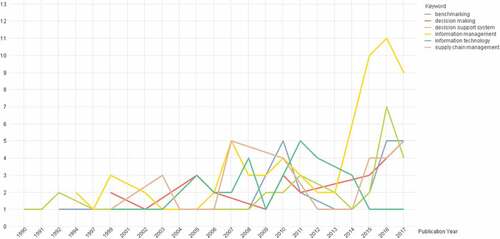
To summarize. By exploring recent publications (2013–2018) we found that keywords; “information management”, “decision support systems”, “supply chain management”, “decision making”, “benchmarking”, and “innovation” are at the top and trending. “Sustainable development” is also found at the top but only apparent during 2016. These represents the direction for contemporary and future mainstream research within the sample.
Analyzing the main top journals, we identified a main interest in operations management by information and analytics combined with decision-making and supply chain. By looking at contributions during conferences we find “information management”, “economics”, “innovation”, and “sustainable development” suggesting a more holistic interest in information management and sustainability.
There has been a steep surge in keywords; “information management”, “decision support systems”, decision making”, and “benchmarking” in the last few years, which indicates an interest in managing information for informed decisions in competitive environments.
4.2. Keyword network analysis
A visual representation of the full sample was constructed by using UCINET/Netdraw (Borgatti et al., Citation2002), including the K-core analysis, and to capture the values of the chosen measures. We have placed the graph in Appendix A (Figure ) as the graph is very dense and difficult to draw any visual conclusions from. The graph represents the full sample with node size after degree centrality. Instead, we turned to density measures to draw conclusions of the network and its cohesion. The network density has an average value of 0.017 with a standard deviation of 0.168 and average weighted degree of 13.733. This is considered very low and presents a weak network. Measuring the geodesic distance inform us that the average geodesic distance is 3 and with std. deviation of 1. This was as expected as two rather distanced conceptual areas of PMS were captured; dynamics and digitalization. Low-density networks indicate poor connections in the network and between its members, and influences the ease of information exchange (Hanneman & Riddle, Citation2005). However, as noted by Wasserman and Faust (Citation1994), a less dense network create interesting opportunities for finding new ideas and opportunities in contrary to a dense network.
A nodal degree informs where the action is in a network (Wasserman & Faust, Citation1994), and the data shows that PMS is being researched with a focus on “information management”, “decision support system”, “benchmarking”, “information technology”, “decision making”, “supply chain management”, “sustainable development”, “competition”, “artificial intelligence”, and “innovation”. This again informs us that the hot-pot of PMS and operations management in competitive environments revolves around digital aid for management of information, in addition to benchmarking, and decision-making in a context of supply chain and sustainability. Note that “information management” has twice the degree of “decision support systems” and 40% larger degree than performance management, thus considerably more central than its fellow actors. The centrality degree in descending order is presented in Figure .
To completely understand the keyword network and actor importance it is necessary to examine multiple relationships (Hanneman & Riddle, Citation2005). In Table the highest values of the selected network measures are presented in descending order. Closeness reveals the distance to all other nodes, and is interpreted as the center of attention, whose view are heard by a larger number of actors as information easily can be distributed (Hanneman & Riddle, Citation2005). Betweenness helps identify the potential of a points communication control (Freeman, Citation1979), as the actor must be between many other actors via their geodesics (Wasserman & Faust, Citation1994). From the keywords in Table we see few keywords that share high closeness, betweenness, and degree. These are: “information management”, “information technology”, “decision support systems”, and “decision making”. These are the most central and important concepts in the PMS literature focused on rapid change. Some caution should be taken using closeness as a measure in larger networks (Hanneman & Riddle, Citation2005), so to conclude the centrality analysis we use Eigenvector which measures the smallest farness from others relative to the overall structure (Hanneman & Riddle, Citation2005). In Table we see the eigenvalue for each keyword supporting centrality of the keywords, especially “information management”. The top two are two times larger than the third. This means they are twice as important in the network, which supports previous results around “information management” as a central and important concept in the network. Farness, longest geodesic distance to other nodes, reveals a small cluster of niched information management topics (“information: quality, technology use, technology optimization”) together with topics on dynamics (“dynamics”, “dynamic web applications”, and “supply chain dynamics”) suggesting interesting niche concepts for future research.
Table 2. Top 15 centrality measures in descending order. 1 means highest degree, 15 means the lowest degree
Table 3. Eigenvector for top 15 keywords
As the keywords DC and AM have not yet been found in the network they were identified “manually”, noting the geodesic distance between “performance measurement” and “dynamic capabilities” to be 1 (see Table ), thus indicating a direct link. Else, there are two steps between the main keywords. Our second discovery is what is not seen. The keyword “algorithmic management” is absent among the keywords, which suggests a significant opportunity for further research as it is both a contemporary popular topic and highly related to PMS. For DC topics, degree centrality is almost 0 (0 with three decimals) (See Table ). This can be compared by degree of 25 while the keyword “performance measurement” had 1258. Eigenvector is 0.013, which is low for the network. Such low degree centrality signals keywords are in the periphery and not central to the mainstream discourse (Freeman, Citation1979), as does a low Eigenvector. As such, DC and AM are found in the periphery and represent another underdeveloped research topic.
Table 4. Geodesic distance between main topics keywords
Table 5. Main topic keywords centrality by degree and Eigenvector
As shown, there is a direct link between “performance measurement” and dynamic capabilities”. with a geodesic path of 1 which are discussing performance measurement and DC specifically. These articles are presented in Table , where Rodney McAdam and Brendan Galbraith are the main contributors. It is also noted that the produced articles were all published last year, suggesting a topic on the rise Although the frequency is too low to say so for sure.
Table 6. Presents four articles with links between PMS and DC. The linking keyword is “performance measurement” and “dynamic capabilities”
To identify subgroups within the network, a k-core analysis was performed with node size after degree centrality. This is presented in Figure . Five subgroups were identified after limiting the relationships to >3 to first focus on the main groups but also enabling visualization of the graph. One subgroup represents the keywords with the highest degree centrality and can as such be considered to be most influential group in the network.
Figure 10. K-core analysis with relations >3 and node size after degree. Five main subgroups identified.
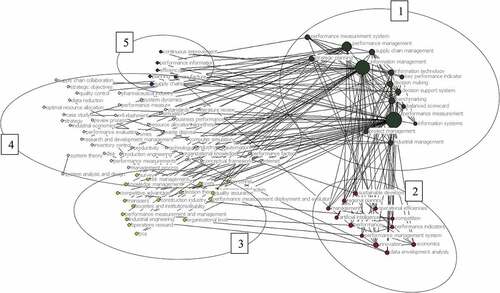
Since they form a cohesive subgroup they are connected and concepts overlap (Doerfel & Barnett, Citation1999) and they can be conceptually summarized, see Table .
Table 7. Analysis of the potential concept emerging from the subgroups. Group 1 with highest degree centrality
Conceptual group numbers 1, 2, 4, and 5 are leaning towards high degree of technology application and innovation with information management and decision-making combined with continuous improvement for optimization and automatization. This either in a supply chain or manufacturing context with an interest in sustainability. These groups are more suitable to explore PMS under periods of stability, however, highly competitive, as they are close to AM, automatization, digitalization, and Industry 4.0. The concepts are related because companies in highly competitive and moderately stable environments tend to automate and digitalize their processes to increase efficiencies (Schildt, Citation2017). As decisions are being automated and highly data-driven (McAfee & Brynjolfsson, Citation2012; Schildt, Citation2017) there is a move to replace managerial functions. Such AM entails software algorithms that assume managerial functions and surrounding institutional devices (Lee et al., Citation2015). We also learned that efficiencies are gained from analyzing large data sets for increased optimization (Schildt, Citation2017). Another solution spanning the entire supply chain, with a very high degree of automatization, is Industry 4.0, with modern information and communication technologies, which increase productivity, quality, and agility that have significant competitive value (Sihn, Citation2014). The manufacturing context also stands out in Industry 4.0.
Conceptual group 3 is putting people at the center of the organization and consider knowledge and decision-making a competitive advantage. This group is more capable of exploring PMS and DC as managers in dynamic environments to a higher extent need to rely on real-time information and intense communication among all participants to rapidly adapt to the environment. Uncertainty is high in a highly dynamic environment and the ability to recognize opportunities highly depends on the individuals or the company’s capabilities and existing knowledge, and requires the ability to build hypotheses around market and trends directions (Teece, Citation2007). It is also suggested that decentralization of decision rights and team-work together with flexible task responsibilities improves performance in dynamic environments (Teece, Citation2007). In markets where the competitive landscape is shifting, the capabilities where managers integrate, build, and reconfigure resources (Teece et al., Citation1997), and especially the management of knowledge resources (Eisenhardt & Martin, Citation2000) instead become the source of sustained competitive advantage. Researchers interested in further endeavors in PMS and rapid change may well explore concepts around these two themes.
By summarizing our findings, centrality measures informed us that “information management”, “information technology”, “decision support systems”, “benchmarking”, and “decision making” are the most central and important concepts in the PMS literature focused on dynamics and rapid change.
Gaps were identified by:
• Eccentricity measures that revealed a niched focus on information as potential for future research, with a central keyword being “information management”. Areas of dynamics was identified as a gap in the PMS research on rapid change.
• Manual gap analysis on DC, and AM, which revealed that neither is incorporated fully in the PMS literature. However, a few articles were identified with two main contributors within PMS and DC.
K-core analysis identified subgroups in the network and interesting conceptual areas for future research. One group leans towards technology application and innovation with information management and decision-making combined with continuous improvement for optimization and automatization. Another group leans towards putting people at the center of the organization and consider knowledge and decision-making a competitive advantage.
5. Conclusion
The study has explored the performance management literature in the context of a dynamic, changing, and competitive environment. In answering the first research question, which was related to PMS in highly dynamic, constantly changing environments, we found that there is a link between PMS, dynamics, and DC, but that the link is weak. There are few articles written that incorporate the two theories which could suggest an increasing interest. However, the mainstream PMS literature within the sample does not point in the direction of exploring dynamics and/or DC theory.
The second research question was related to PMS and digitalization, application of algorithms or AI. We identified the link to this area as stronger compared to dynamics, with central keywords such as “information management”, “information technology”, “decision support systems”, “decision making”, and “artificial intelligence”. In addition, the mainstream literature in the sample points in the direction of an interest in managing information for informed decisions in a competitive environment with trending keywords such as “information management”, “decision support systems”, “decision making”, and “benchmarking”. This may reflect a situation where we possess an abundance of information available for informed decisions while we require a “system” to synthesize and analyze the information. Identification of geodesics between AM and PMS revealed that the link to AM does not exist. That the link is not present shows an unexplored area of research, which is noteworthy since AM has strong ties to PMS. The gap may be explained by the topic newness, which was also identified during the first search on AM in Scopus.
This has several implications, both conceptually and empirically. First, interesting opportunities to develop PMS theory that supports dynamic capabilities may be overlooked by not incorporating DC theory in PMS research. The question of what PMS in highly dynamic environments are that supports achieving congruence with the changing business environment strategies remains open. PMS designed incorporating dynamic capabilities needs to support flexible strategies and the capabilities to integrate, build, and reconfigure resources, and especially the management of knowledge resources to create series of temporary advantages. Topics on dynamics had a high farness and only a few articles have been written incorporating the two topics simultaneously. This calls for more empirical studies on the subject. Through K-core analysis we identified a conceptual research subgroup (number 3) where people are placed at the center of the organization, and knowledge and decision-making considered providing a competitive advantage. Conceptually, this research group is suitable for researching PMS and DC as managers in dynamic environments to a high degree rely on real-time information and intense communication among participants to rapidly adapt to the environment. Nonetheless, digitalization needs to be incorporated in studies on DC and PMS as change and dynamics are highly intertwined.
Second, the centrality and frequency of keywords in the sample identified a large and mainstream interest in “information management”, “decision support systems”, “decision making”, “information technology”, “benchmarking” and “artificial intelligence”. These concepts are central in the sample. It conceptually means PMS theory primarily is being developed for moderately stable environments, not dynamic and changing ones. The conclusion is supported by the higher degree of stability that is required to streamline processes for such efficiency and investment in technology and development (for example in automatization). Moving forward we expect to see PMSs’ that are highly advanced, developed around streamlined processes, and target a large amount of daily tactical decisions rather than the few and strategic ones. A PMS supporting strategic management may even be developed based on DC theory. Through the K-core analysis, we identified four out of five subgroups exploring technology applications with information management, artificial intelligence, data analysis, automations, and decision-making together with continuous improvement for optimization, efficiencies, and automatization in competitive environments. That the groups were positioned this way reveals the locus of PMS research in competitive environments. Researchers that choose to position themselves relative the subgroup who better fit with AM and automatization is a rather engineered group and would perhaps take a technical approach to further explore PMS together with AM, Industry 4.0, and AI.
Third, for managers the implications of PMS not incorporating DC theory will create an unbalanced body of research. Tools, techniques, and technology required to compete in the short run and in temporary stable environments will be well developed while research will be less capable in assisting in how to develop PMSs’ that move synchronously with changing market conditions and assist strategic decision-making for repeated temporary advantages that meet the needs of tomorrow or help to keep pace without knowing the future.
Last, for researchers interested in more niched topics, eccentricity measures revealed topics of information (“information: quality, technology use, technology optimization”) together with topics on dynamics (“dynamics”, “dynamic web applications”, and “supply chain dynamics”) for future research. Those interested in investigating niched areas of information and dynamics may leverage from the centrality of “information” in general to gain traction in the community. Information management did have a two times higher Eigenvector, giving it a significant presence in the network. The K-core analysis revealed five sub-groups in the network which conceptually may be bundled to just two groups, each presenting a conceptual context to position future research. The two groups are suitable for further exploration of either DC and taking an organizational or human capital perspective, or digitalized and exploring or AM, automatization and optimization of PMS in a highly dynamic environment.
5.1. Limitations and further work
The analyzed sample contained a sufficient sample of 241 articles, but computer power is a limitation. Additional studies with a larger dataset are recommended to strengthen and validate the findings. In addition, quantitative studies such as this are recommended to be supported by qualitative findings. A next step would be to deepen the understanding of performance systems in dynamic environments through several case studies.
Additional information
Funding
Notes on contributors
Jonatan Sahlin
Jonatan Sahlin is a researcher at the Royal Institute of Technology (KTH) where he investigates how rapidly changing business environments affect companies’ operations strategically, and how performance management systems can support such operations. In parallel he is a business developer in strategy and commercial excellence at a multinational corporation working on digitalization and strategic level business development toward market leading retailers.
Jannis Angelis
Jannis Angelis is Docent at the Royal Institute of Technology (KTH), and Researcher at the Research Institute of Industrial Economics (IFN). Jannis read a PhD at Cambridge focusing on operational flexibility. He also explored strategy at Harvard, flexibility and productivity at Stanford and Berkeley, the human side of lean at Cambridge, and high-performance organizations at Oxford and MIT. Current research explores: Blockchain 4.0; Algorithmic management and digitalization in finance.
References
- Angelis, J., & Ribeiro Da Silva, H. (2019). Blockchain adoption: A value driver perspective. Business Horizons, 63(2). Retrieved from https://www.sciencedirect.com/science/article/pii/S0007681318302088
- Bititci, U. S., Carrie, A. S., & Mcdevitt, L. (1997). Integrated performance measurement systems: An audit and development guide. The TQM Magazine, 9(1), 46–21. doi:10.1108/09544789710159443
- Bititci, U. S., Turner, U., & Begemann, C. (2000). Dynamics of performance measurement systems. International Journal of Operations & Production Management, 20(6), 692–704. Retrieved from http://www.emeraldinsight.com/doi/full/10.1108/01443570010321676
- Borgatti, S. P., Everett, M. G., & Freeman, L. C. (2002). UCINET 6 for windows: Software for social network analysis. Harvard, MA: Analytic Technologies. Retrieved from https://www.bibsonomy.org/bibtex/2760c85a6db2aa933963b1410aaee04c7/cabird
- Bourne, M., et al. (2003). Implementing performance measurement systems : A literature review. International Journal of Performance Management, 5(1), 1–24. Retrieved from https://www.inderscienceonline.com/doi/abs/10.1504/IJBPM.2003.002097
- Bourne, M., & Neely, A. (2003). Why some performance measurement initiatives fail: Lessons from the change management literature. International Journal of Performance Management, 5(2), 246–269. Retrieved from http://www.inderscienceonline.com/doi/abs/10.1504/IJBPM.2003.003250
- Choong, K. K. (2013). Understanding the features of performance measurement system: A literature review. Measuring Business Excellence, 17(4), 102–121. doi:10.1108/MBE-05-2012-0031
- Constantiou, I. D., & Kallinikos, J. (2015). New games, new rules : Big data and the changing context of strategy. Journal of Information Technology, 30(1), 44–57. doi:10.1057/jit.2014.17
- Davenport, T. H. (2014). How strategists use “big data” to support internal business decisions, discovery and production. Strategy and Leadership2, 42(4), 45–50. doi:10.1108/SL-05-2014-0034
- De Lima, E. P., Da Costa, S. E. G., & Angelis, J. J. (2008). The strategic management of operations system performance. International Journal of Business Performance Management, 10(1), 108–132. doi:10.1504/IJBPM.2008.015924
- Delen, D., & Demirkan, H. (2013). Data, information and analytics as services. Decision Support Systems, 55(1), 359–363. Elsevier B.V. doi:10.1016/j.dss.2012.05.044.
- Doerfel, M., & Barnett, G. (1999). A semantic network analysis of the International Communication Association. Human Communication Research, 25(4), 589–603. Retrieved from http://onlinelibrary.wiley.com/doi/10.1111/j.1468-2958.1999.tb00463.x/full
- Dotsika, F., & Watkins, A. (2017). Identifying potentially disruptive trends by means of keyword network analysis. Technological Forecasting and Social Change, 119, 114–127. doi:10.1016/j.techfore.2017.03.020
- Drieger, P. (2013). Semantic network analysis as a method for visual text analytics. Procedia - Social and Behavioral Sciences, 79, 4–17. Elsevier B.V. doi:10.1016/j.sbspro.2013.05.053
- Eisenhardt, K. M., & Martin, J. A. (2000). Dynamic capabilities: What are they? Strategic Management Journal, 21(10–11), 1105–1121. doi:10.1002/1097-0266(200010/11)21:10/11<1105::AID-SMJ133>3.0.CO;2-E
- Franco-Santos, M., Lucianetti, L., & Bourne, M. (2012). Contemporary performance measurement systems: A review of their consequences and a framework for research. Management Accounting Research, 23(2), 79–119. Elsevier Ltd. doi:10.1016/j.mar.2012.04.001
- Freeman, L. C. (1979). Centrality in social networks conceptual clarification. Social Networks, 1(1968), 215–239. doi:10.1016/0378-8733(78)90021-7
- George, G., & Lin, Y. (2017). Analytics, innovation, and organizational adaptation. Innovation, 19(1), 16–22. Routledge. doi:10.1080/14479338.2016.1252042
- Hanneman, R. A., & Riddle, M. (2005). Introduction to social network methods. University of California.
- Hanson, J. D., Melnyk, S. A., & Calantone, R. A. (2011). Defining and measuring alignment in performance management. International Journal of Operations and Production Management, 31(10), 1089–1114. doi:10.1108/01443571111172444
- Kaplan, R. S., & Norton, D. P. (2007). Using the balanced scorecard as a strategic management system. Harvard Business Review, 1–14. Retrieved from https://hbr.org/2007/07/using-the-balanced-scorecard-as-a-strategic-management-system
- Kennerley, M., & Neely, A. (2002). A framework of the factors affecting the evolution of performance measurement systems. International Journal of Operations and Production Management, 22(11), 1222–1245. doi:10.1108/01443570210450293
- Kennerley, M., & Neely, A. (2003). Measuring performance in a changing business environment. International Journal of Operations and Production Management, 23(2), 213–229. doi:10.1108/01443570310458465
- Kim, J., & Jang, S. (2017). Keyword network analysis on the research trends of life-long education for people with disabilities in Korea. 11(7), 1846–1849. Retrieved from https://waset.org/Publication/keyword-network-analysis-on-the-research-trends-of-life-long-education-for-people-with-disabilities-in-korea/10007504
- Kolehmainen, K. (2010). Dynamic strategic performance measurement systems: Balancing empowerment and alignment. Long Range Planning, 43(4), 527–554. Elsevier Ltd. doi:10.1016/j.lrp.2009.11.001
- Lee, M. K., Kusbit, D., Metsky, E., Dabbish, L. (2015). Working with machines: The impact of algorithmic and data-driven management on human workers. ACM CHI’15 Conference on Human Factors in Computing Systems, 1, 1603–1612. doi:10.1145/2702123.2702548
- Li, X., Wu, Q., & Holsapple, C. W. (2015). Best-value supply chains and firms’ competitive performance: Empirical studies of their linkage. International Journal of Operations and Production Management, 35(12), 1688–1709. doi:10.1108/IJOPM-01-2014-0014
- McAdam, R., Bititci, U., & Galbraith, B. (2017). Technology alignment and business strategy: A performance measurement and dynamic capability perspective. International Journal of Production Research, 55(23), 7168–7186. doi:10.1080/00207543.2017.1351633
- McAdam, R., Humphreys, P., Galbraith, B., & Miller, K. (2017). Developing management capability within a horizontal supply chain in performance measurement deployment and evolution: A dynamic capabilities and goal theory perspective. Production Planning & Control, 28(6–8), 610–628. Retrieved from https://www.tandfonline.com/doi/abs/10.1080/09537287.2017.1309706
- McAfee, A., & Brynjolfsson, E. (2012, October). Big data: The management revolution. Harvard Business Review, Retrieved from https://hbr.org/2012/10/big-data-the-management-revolution
- Melnyk, S. A., Bititci, U., Platts, K., Tobias, J., & Andersen, B. (2014). Is performance measurement and management fit for the future? Management Accounting Research. Elsevier, 25(2), 173–186. doi:10.1016/j.mar.2013.07.007
- Micheli, P., & Manzoni, J. F. (2010). Strategic performance measurement: Benefits, limitations and paradoxes. Long Range Planning, 43(4), 465–476. Elsevier Ltd. doi:10.1016/j.lrp.2009.12.004
- Micheli, P., & Mura, M. (2017). Executing strategy through comprehensive performance measurement systems. International Journal of Operations & Produciton Management, 37(4), 423–443. Emerald Ltd. doi:10.1108/IJOPM-08-2015-0472
- Najmi, M., Rigas, J., & Fan, I.-S. (2005). A framework to review performance measurement systems. Business Process Management Journal, 11(2), 109–122. doi:10.1108/14637150510591129
- Neely, A. (1997). A practical approach to defining key indicators. Measuring Business Excellence, 1(1), 42–46. Retrieved from http://www.emeraldinsight.com/doi/abs/10.1108/eb025468
- Neely, A. (1999). The performance measurement revolution: Why now and what next? International Journal of Operations & Production Management, 19(2), 205–228. doi:10.1108/01443579910247437
- Neely, A. (2005). The evolution of performance measurement research: Developments in the last decade and a research agenda for the next. International Journal of Operations & Production Management, 25(12), 1264–1277. doi:10.1108/01443570510633648
- Peters, M. D., Wieder, B., Sutton, S. G., & Wakefield, J. (2016). Business intelligence systems use in performance measurement capabilities: Implications for enhanced competitive advantage. International Journal of Accounting Information Systems, 21, 1–17. doi:10.1016/j.accinf.2016.03.001
- Pilkington, A., & Liston-Heyes, C. (1999). Is production and operations management a discipline? A citation/co-citation study. International Journal of Operations & Production Management, 19(1), 7–20. doi:10.1108/01443579910244188
- Schildt, H. (2017). Big data and organizational design - the brave new world of algorithmic management and computer augmented transparency. Innovation, 19(1), 23–30. Routledge. doi:10.1080/14479338.2016.1252043
- Sihn, W. (2014). Advances in industrial cyber-physical systems. In Industry 4.0 - Potentials, opportunities and roadmap. Retrieved from http://www.europe-aim.eu/wp-content/uploads/2012/07/Sihn-Industrie-4.0-Potentials-Opportunities-and-Roadmap.pdf
- Srimai, S., Radford, J., & Wright, C. (2011). Evolutionary paths of performance measurement: An overview of its recent development. International Journal of Productivity and Performance Management, 60(7), 662–687. doi:10.1108/BIJ-10-2012-0068
- Taticchi, P., Balachandran, K., & Tonelli, F. (2012). Performance measurement and management systems: State of the art, guidelines for design and challenges. Measuring Business Excellence, 16(2), 41–54. doi:10.1108/13683041211230311
- Taticchi, P., & Balachandran, K. R. (2008). Forward performance measurement and management integrated frameworks. International Journal of Accounting and Information Management, 16(2), 140–154. doi:10.1108/18347640810913807
- Taticchi, P., Tonelli, F., & Cagnazzo, L. (2010). Performance measurement and management: A literature review and a research agenda. Measuring Business Excellence, 14(1), 4–18. doi:10.1108/13683041011027418
- Taticchi, P., Tonelli, F., & Pasqualino, R. (2013). Performance measurement of sustainable supply chains: A literature review and a research agenda. International Journal of Productivity and Performance Management, 62(8), 782–804. doi:10.1108/IJPPM-03-2013-0037
- Teece, D. J. (2007). Explicating dynamic capabilities: The nature and microfoundations of (sustainable) enterprise performance. Strategic Management Journal, 28(13), 1319–1350. doi:10.1002/smj.64()Received
- Teece, D. J., Pisano, G., & Shuen, A. (1997). Dynamic capabilities and strategic management. Strategic Management Journal, 18(7), 509–533. doi:10.1002/(SICI)1097-0266(199708)18:7<509::AID-SMJ882>3.0.CO;2-Z
- Tranfield, D., Denyer, D., & Smart, P. (2003). Towards a methodology for developing evidence-informed management knowledge by means of systematic review. British Journal of Management, 14, 207–222. doi:10.1111/1467-8551.00375
- Wasserman, S., & Faust, K. (1994). Social Network Analysis. New York: Cambridge University Press.
- Webster, J., & Watson, R. T. (2002). Analyzing the past to prepare for the future: Writing a literature review. MIS Quarterly, 26(2), 13–23. doi: 10.1.1.104.6570

